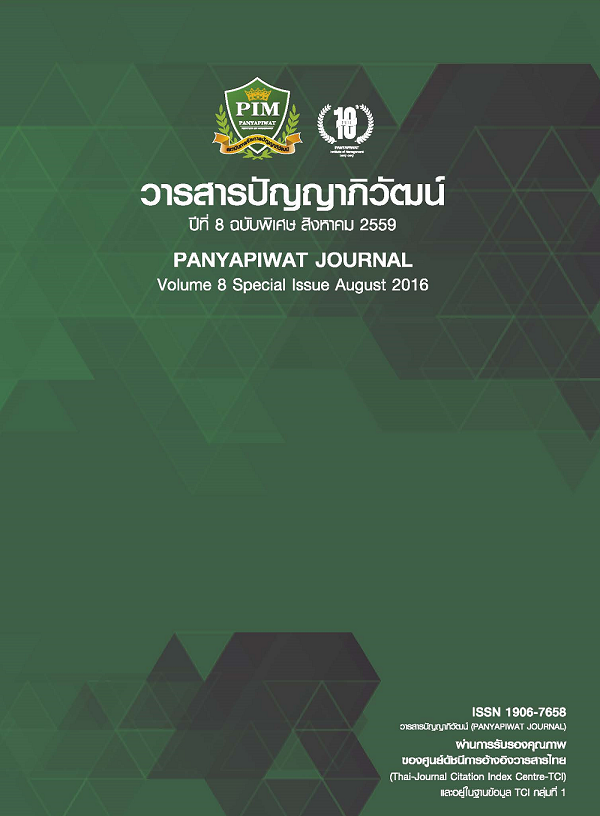การเปรียบเทียบแบบจำลอง CAPM และ APT เพื่อวิเคราะห์อัตราผลตอบแทนและความเสี่ยงของหลักทรัพย์ SET50
Main Article Content
บทคัดย่อ
การศึกษาอิสระในครั้งนี้มีวัตถุประสงค์ เพื่อเปรียบเทียบความสามารถในการคำนวณอัตราผลตอบแทนและความเสี่ยงของหลักทรัพย์กลุ่ม SET50 จากแบบจำลอง CAPM (Capital Asset Pricing Model) และแบบจำลอง APT (Arbitrage Pricing Theory Model) รวมถึงการนำอิทธิพลทางปัจจัยเศรษฐกิจมหภาคที่มีผลต่ออัตราผลตอบแทนและความเสี่ยงของหลักทรัพย์มาใช้ในการศึกษา ได้แก่ อัตราการค้า (Term of Trade) ราคาน้ำมัน (Oil Price) อัตราผลตอบแทนของตลาดโลก (MSCI Index) ดัชนีราคาผู้บริโภค (Consumer Price Index) อัตราดอกเบี้ยกู้ยืมระหว่างธนาคาร (Interbank Rate) ปริมาณเงิน (Money Supply) และอัตราแลกเปลี่ยนบาทต่อดอลลาร์สหรัฐ (Exchange Rate) โดยนำข้อมูลมาทดสอบกับกลุ่มหลักทรัพย์ SET50 ที่อยู่ในตลาดหลักทรัพย์แห่งประเทศไทย ซึ่งจะใช้ข้อมูลรายเดือนของช่วง มกราคม ถึง ธันวาคม ระหว่างปี 2552 ถึง 2557 รวมทั้งสิ้น 72 เดือน
ผลการศึกษาครั้งนี้ทำให้ทราบว่าแบบจำลอง APT สามารถคำนวณอัตราผลตอบแทนและความเสี่ยงของกลุ่มหลักทรัพย์ SET50 ได้ดีกว่าแบบจำลอง CAPM ซึ่งเห็นได้ชัดเจนในหลักทรัพย์ทุกๆ หลักทรัพย์ที่อยู่ในกลุ่มหลักทรัพย์ SET50 ที่มีค่า RMSE (Root Mean Square Error) และค่า U2 (Theil’s Inequality Coefficient) จากการคำนวณของแบบจำลอง มีค่าน้อยกว่าคือแบบจำลอง APT
The purposes of this independent study were to compare the calculation on risks and returns of the SET50 securities with the capital asset pricing model (CAPM) and the arbitrage pricing theory model (APT) and to study the influence of the macroeconomic factors affecting the rate of risks and returns on securities including the term of trade, the oil price, the MSCI index, the consumer price index, the interbank rate, the money supply, and the exchange rate (Baht/USD). The monthly data from January to December of 2009 to 2014 (72 months) were used in this study.
The result from this independent study found that the arbitrage pricing theory model (APT) could calculate the risks and returns of SET50 securities better than the capital asset pricing model (CAPM). This could be seen clearly in every securities in SET50 securities that securities with the RMSE (Root Mean Square Error) and U2 (Theil's Inequality Coefficient) from the model calculation that had a minimal value was the arbitrage pricing theory model (APT).
Article Details
“ข้าพเจ้าและผู้เขียนร่วม (ถ้ามี) ขอรับรองว่า บทความที่เสนอมานี้ยังไม่เคยได้รับการตีพิมพ์และไม่ได้อยู่ระหว่างกระบวนการพิจารณาลงตีพิมพ์ในวารสารหรือแหล่งเผยแพร่อื่นใด ข้าพเจ้าและผู้เขียนร่วมยอมรับหลักเกณฑ์การพิจารณาต้นฉบับ ทั้งยินยอมให้กองบรรณาธิการมีสิทธิ์พิจารณาและตรวจแก้ต้นฉบับได้ตามที่เห็นสมควร พร้อมนี้ขอมอบลิขสิทธิ์บทความที่ได้รับการตีพิมพ์ให้แก่สถาบันการจัดการปัญญาภิวัฒน์หากมีการฟ้องร้องเรื่องการละเมิดลิขสิทธิ์เกี่ยวกับภาพ กราฟ ข้อความส่วนใดส่วนหนึ่งและ/หรือข้อคิดเห็นที่ปรากฏในบทความข้าพเจ้าและผู้เขียนร่วมยินยอมรับผิดชอบแต่เพียงฝ่ายเดียว”
เอกสารอ้างอิง
กฤษณุ ลือกำลัง. (2556). การวิเคราะห์ความเสี่ยงและผลตอบแทนจากการลงทุนในหลักทรัพย์ ที่จดทะเบียนในตลาดหลักทรัพย์แห่งประเทศไทยโดยเปรียบเทียบแบบจำลอง CAPM และ APT. วิทยานิพนธ์ปริญญาเศรษฐศาสตรมหาบัณฑิต มหาวิทยาลัยขอนแก่น.
ชานน ชูเกษมรัตน์. (2552). การวิเคราะห์ผลตอบแทน ความเสี่ยง และประเมินมูลค่าของหลักทรัพย์ในกลุ่มธนาคารขนาดใหญ่โดยใช้แบบจำลอง CAPM. เชียงใหม่: คณะเศรษฐศาสตร์ มหาวิทยาลัยเชียงใหม่.
ณัฏฐภัทร สุนทรวาทิน. (2552). การศึกษาความเสี่ยงและประเมินผลตอบแทนที่เหมาะสมของหลักทรัพย์ในกลุ่มพลังงานในตลาดหลักทรัพย์แห่งประเทศไทยโดยใช้แบบจำลอง CAPM. เชียงใหม่: คณะเศรษฐศาสตร์ มหาวิทยาลัยเชียงใหม่.
ตลาดหลักทรัพย์แห่งประเทศไทย. (2558). รายชื่อบริษัทหลักทรัพย์ SET50. สืบค้นเมื่อ 13 มีนาคม 2558, จาก http://www.set.or.th/set/commonslookup.do?language=th&country=TH
เพ็ญญดา เสาโร. (2554). การวิเคราะห์การลงทุนในหลักทรัพย์ในตลาดหลักทรัพย์แห่งประเทศไทย โดยใช้แบบจำลอง CAPM ตั้งแต่ปี พ.ศ. 2549 ถึง พ.ศ. 2553. วิทยานิพนธ์ปริญญาบริหารธุรกิจมหาบัณฑิต มหาวิทยาลัยขอนแก่น.
วิรัชอร ศรีทรัพย์. (2548). การวิเคราะห์และเปรียบเทียบความสัมพันธ์ระหว่างอัตราผลตอบแทนและความเสี่ยงตามแบบจำลอง CAPM และ APT. ภาคนิพนธ์ปริญญาเศรษฐศาสตรมหาบัณฑิต สถาบันบัณฑิตพัฒนบริหาร-ศาสตร์.
วิไลพรรณ ตาริชกุล. (2551). รูปแบบจำลอง CAPM การศึกษาเปรียบเทียบความเสี่ยงและอัตราผลตอบแทนของหลักทรัพย์กลุ่มธนาคาร. วิทยานิพนธ์ปริญญาบริหารธุรกิจมหาบัณฑิต มหาวิทยาลัยรามคำแหง.
วีระ ชวลิต. (2543). การเปรียบเทียบแบบจำลอง CAPM และ APT ในการอธิบายความสามารถในการทำนายอัตราผลตอบแทนหุ้น. วิทยานิพนธ์ปริญญาเศรษฐศาสตรมหาบัณฑิต จุฬาลงกรณ์มหาวิทยาลัย.
สุนทรี กัลชาญพิเศษ. (2539). การตัดสินใจลงทุนในตลาดหลักทรัพย์แห่งประเทศไทยโดยใช้แบบจำลอง APT.วิทยานิพนธ์ปริญญาเศรษฐศาสตรมหาบัณฑิต มหาวิทยาลัยเชียงใหม่.Bloomberg. (2015). MSCI INDEX. Retrieved June 21, 2015, from http://www.bloomberg.com
Brigham, E. F. & Houston, J. F. (1996). Fundamentals of Financial Management. The Concise Edition. Florida: The Dryden press.
Febrian, E. & Herwany, A. (2010). The Performance Of Asset Pricing Models Before, During And After An Emerging Market Financial Crisis : Evidence Form Indonesia. International Journal of Business and Finance Research, 4(1), 85-97.
Muzur, E., Bulut, N. & Sengul, S. (2010). The Predication Performance Of Asset Pricing Models And Their Capability Of Capturing The Effect Of Economic Crises: The Case Of Istanbul Strock Exchange. Journal of Business Research, 2(3), 3-24.
Ross, S. A., Westerfield, R. W. & Jaffe, J. (1996). Corporate Finance (4th ed.). Chicago: IRWIN.
Translated Thai References
Chawalit, V. (2000). The Comparison CAPM and APT Models to Analysis Risks and Returns of Securities. Master of Economics Program, Chulalongkorn University. [in Thai]
Chukasemrat, C. (2009). Analysis Risk Return and Valuation in Banking Sector by CAPM Moddel. Chiangmai: Factor of Economics, Chiangmai University. [in Thai]
Kanchanpiset, S. (1996). The Decision to Investing in The Stock Exchange of Thailand by APT.Master of Economics Program, Chiangmai University. [in Thai]
Luekumlung, K. (2013). A Comparative Analysis of The Risks and Returns of Investing in Securities Listed on The Stock Exchange of Thailand Based on CAPM and APT Models. Master of Economics Program in Business Economics, Khon Kaen University. [in Thai]
SET. (2015). SET50 Company listed. Retrieved March 13, 2015, from http://www.set.or.th/set/commonslookup.do?language=th&country=TH [in Thai]
Soaro, P. (2011). Investment Analysis in The Stock Exchange of Thailand by CAPM Model since 2006 to 2010. Master of Business Administration College of Graduate Study in Management, Khon Kaen University. [in Thai]
Srisurb, V. (2005). Compare Analysis Risk and Return by CAPM and APT Model. Master of Economics Program in Financial Economics, NIDA. [in Thai]
Suntornwatin, N. (2009). The study of Risk and Return from Securities Energy Sector in The Stock Exchange of Thailand by CAPM Model. Chiangmai: Factor of Economics, Chiangmai University. [in Thai]
Tarichakul, V. (2008). Capital Asset Pricing Model to Comparative Risk and Return of Bank Securities.Master of Business Administration, Ramkhamhaeng University. [in Thai]


